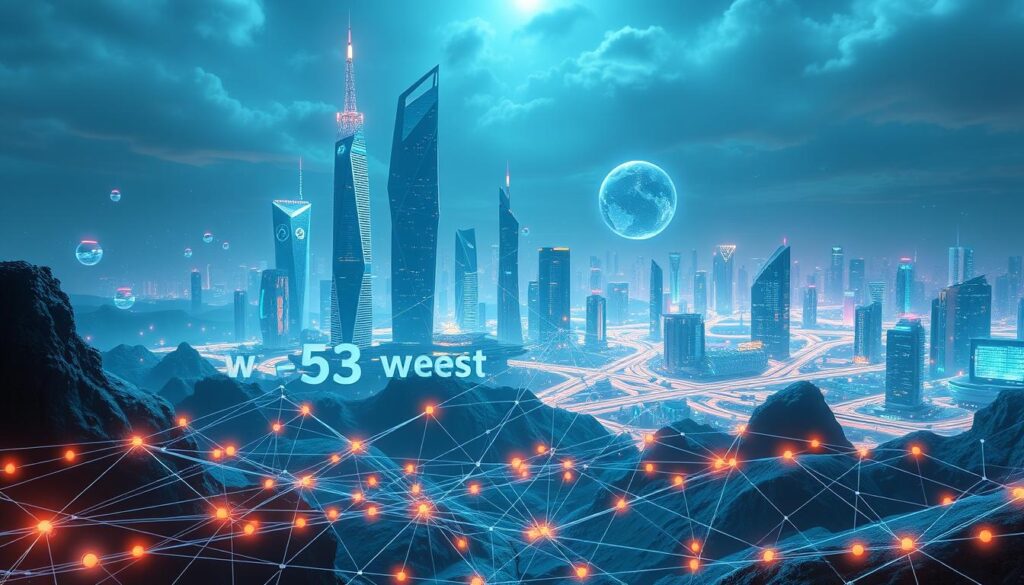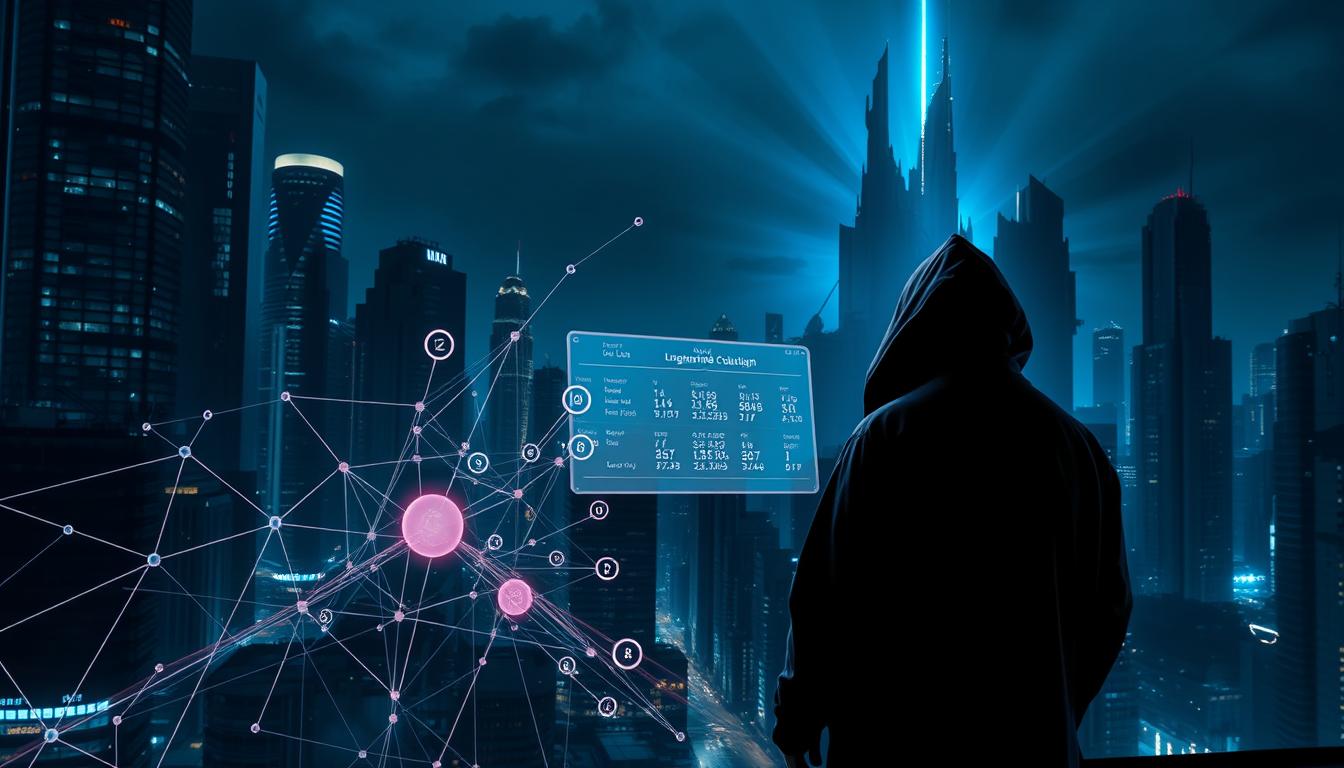Now Reading: Understanding Blockchain Future Trends Predictions Next Decade
- 01
Understanding Blockchain Future Trends Predictions Next Decade
Understanding Blockchain Future Trends Predictions Next Decade

The world of digital systems is changing fast. A technology first explored in the 1990s is now gaining major traction. This shift is powered by cryptocurrency popularity and a push for more digital tools.
Market research from Fortune Business Insights shows a huge jump is expected. The global market for this technology could grow from $27.84 billion in 2024 to over $825 billion by 2032. This shows a move into the mainstream for businesses.
This article will explore what’s coming next. We will look at key ideas like DeFi, Web3, and NFTs. These areas are set to change how we use the internet and handle data.
Understanding these changes is vital for many people. Business leaders, developers, and investors need to know what is happening. This knowledge helps them make smart choices in a fast-moving digital economy.
Key Takeaways
- The market for this digital ledger technology is projected for massive expansion this decade.
- Initial development began decades ago, but recent events have accelerated its adoption.
- Concepts like decentralized finance and Web3 will be central to its ongoing evolution.
- The practical uses extend far beyond its original financial applications.
- Staying informed is crucial for professionals navigating the modern technological landscape.
Introduction to Future Blockchain Trends
Modern digital infrastructure owes much to pioneering work from the late 20th century. The foundation for today’s distributed systems emerged from decades of cryptographic research.
Background and Evolution of Blockchain
Key innovations began appearing in the 1970s. Ralph Merkle’s tree structure in 1979 provided essential data organization. David Chaum’s digital cash system introduced secure electronic transactions.
Stuart Haber’s timestamping method and Proof of Work concepts followed. These pieces came together in 2008 when Satoshi Nakamoto published the Bitcoin white paper. This created a peer-to-peer financial system without central authorities.
The early years saw minimal cryptocurrency value. In 2010, programmer Laszlo Hanyecz famously paid 10,000 Bitcoin for two pizzas. This transaction highlighted the technology’s experimental stage.
| Year | Development | Significance |
|---|---|---|
| 1979 | Merkle Tree Concept | Foundation for data structure |
| 2008 | Bitcoin White Paper | First practical implementation |
| 2010 | First Bitcoin Transaction | Proved real-world utility |
| 2015 | Ethereum Launch | Enabled smart contracts |
Market Growth and Digital Transformation
A pivotal shift occurred around 2014. Developers began exploring applications beyond cryptocurrency. This expanded the technology’s potential across various industries.
Recent market expansion accelerated during global digitization efforts. Traditional business infrastructure now integrates distributed ledger systems. This maturation positions the technology for widespread enterprise adoption.
The network has evolved from supporting digital currency to managing complex data systems. Current applications span finance, supply chains, and secure information management.
Decentralized Finance and Its Impact on Global Transactions
A new era of peer-to-peer financial services is reshaping global economic interactions. This shift moves control from traditional institutions to open networks.
Transformation in Financial Systems
Decentralized finance platforms eliminate banking intermediaries. They create public financial systems accessible to anyone with internet connectivity.
The sector experienced explosive growth during 2020-2021. Total value locked across networks reached nearly $250 billion. This demonstrates massive adoption of decentralized financial services.
These platforms enable lending, borrowing, and trading through smart contracts. They offer greater accessibility and lower costs than traditional banking. Transparency is significantly enhanced.

Government Initiatives and Global Adoption
National governments are embracing digital currencies at unprecedented levels. El Salvador made Bitcoin legal tender in 2021. The Central African Republic followed in April 2022.
These decisions aim to boost economic growth and financial inclusion. They also seek to maximize remittance efficiency for citizens abroad.
Cross-border payment providers are transitioning to distributed platforms. This shift achieves cost efficiency and faster transaction processing. The traditional remittance industry faces significant disruption.
| Country | Year | Initiative | Primary Goal |
|---|---|---|---|
| El Salvador | 2021 | Bitcoin as legal tender | Financial inclusion |
| Central African Republic | 2022 | Cryptocurrency adoption | Economic growth |
| Various Emerging Markets | 2020-Present | Blockchain payment channels | Cost efficiency |
Central banks worldwide are responding to this transformation. Many are exploring digital currency options. They’re reconsidering their roles in monetary policy control.
The Rise of Web3 and Decentralized Ecosystems
The next evolutionary phase of the internet promises to return data ownership to the people who create it. This movement builds on distributed ledger technology to create more equitable digital spaces.
Understanding Web3 and Its Core Concepts
Web3 represents a complete rethinking of internet architecture. Instead of centralized servers controlled by large organizations, it uses peer-to-peer networks.
Decentralized applications (dApps) operate on open protocols. Users interact directly without corporate intermediaries extracting value. This model rewards participation through tokens that represent ownership stakes.

Enhancing User Data Ownership and Privacy
Current internet models profit from user information. Web3 flips this dynamic by putting individuals in charge of their data.
Technical mechanisms like self-sovereign identity and encrypted storage give people real control. Blockchain-based authentication ensures only authorized access to personal information.
This approach creates stronger privacy protections than traditional systems. The technology enables users to choose how their data gets used.
While complete replacement of existing infrastructure remains debated, decentralization principles are gaining influence. More applications will incorporate these user-centric features over time.
NFTs and the Tokenization of Real Assets
Non-fungible tokens represent a breakthrough in authenticating digital and physical property rights. These unique digital certificates use blockchain technology to establish verifiable ownership.

Each NFT contains specific data that proves its authenticity and origin. This innovation creates digital scarcity for items that were previously easy to copy.
The Digital Art Revolution and Beyond
The art world experienced a seismic shift with NFT technology. High-profile sales like the Bored Ape Yacht Club collection demonstrated the potential. One piece sold for $3.4 million in 2021.
Digital creators now have powerful tools to monetize their work. NFTs provide immutable proof of ownership that was previously unavailable. Artists receive compensation through automated royalty systems.
Marketplaces for these digital assets have generated billions in trading volume. They create new investment opportunities and collector communities. The market continues to expand rapidly.
Tokenization extends far beyond digital art into real-world assets. Property deeds, event tickets, and luxury goods can become NFTs. This technology increases liquidity through fractional ownership.
Businesses leverage NFTs for authentication and customer loyalty programs. The technology enables 24/7 global trading without intermediaries. This represents a significant innovation in asset management.
Play-to-Earn Crypto Gaming Trends
Video games are evolving beyond simple entertainment into sophisticated economic platforms. According to DappRadar and BGA Games, activity in this sector surged by 2,000% recently. Gaming now represents over half of all distributed ledger activity.
Innovations in Game Economics
Play-to-earn models transform how players interact with digital worlds. Instead of just entertainment, users earn valuable tokens through gameplay. These rewards can be converted to traditional currency on digital exchanges.
Leading projects like Axie Infinity, The Sandbox, and Illuvium demonstrate this shift. Their market valuations skyrocketed as players embraced earning opportunities. This creates significant income potential, especially in developing regions.
![]()
NFT-Driven Rewards and Monetization
Non-fungible tokens revolutionize in-game asset ownership. Characters, land, and items become unique digital property. Players can trade these assets on open markets with verified scarcity.
The existing microtransaction industry faces transformation through this technology. Developers earn through initial sales and ongoing royalty fees. This creates aligned incentives between creators and the gaming community.
| Game Project | Primary Feature | Economic Model | User Benefits |
|---|---|---|---|
| Axie Infinity (AXS) | Creature battling | NFT breeding & trading | Daily token rewards |
| The Sandbox (SAND) | Virtual world creation | Land ownership & gaming | Asset appreciation |
| Illuvium (ILV) | RPG adventure | Collectible creatures | Staking returns |
The Metaverse and Immersive Digital Environments
Major corporations are investing heavily in virtual spaces where users interact through advanced computing interfaces. Facebook’s rebranding to Meta signaled a strategic shift toward building interconnected digital worlds. Microsoft is developing workplace services for Teams, while Nike acquired RTFKT to enter virtual fashion.
Integration of Virtual Reality and Blockchain
These immersive environments combine VR headsets, augmented reality, and spatial computing. Users control avatars to work, socialize, and play in persistent 3D worlds. Games like Fortnite and Roblox demonstrate early versions of this concept.
The underlying infrastructure relies on distributed ledger systems for critical functions. Non-fungible tokens enable true ownership of virtual assets like real estate and wearables. Cryptographic verification ensures digital scarcity across different platforms.
Payment systems using digital currencies facilitate seamless transactions within these spaces. This technology supports new business models and creator economies. The integration represents significant innovation for various industries.
Current applications include virtual offices, training simulations, and diplomatic presence. Barbados established an embassy in Decentraland, showing institutional validation. These developments point toward expanded use cases in the coming years.
For more insights on how this technology is evolving, explore the latest blockchain technology trends in 2025 that are shaping these digital environments.
Layer 2 Networks and Multi-Chain Scaling Solutions
Network congestion and high transaction fees have driven innovation in secondary layer technologies. These solutions build upon established base protocols to enhance performance.
Layer 1 systems like Ethereum and Solana provide foundational security. However, they face limitations in transaction speed as adoption grows.
Enhancing Scalability with Layer 2 Technologies
Layer 2 networks process transactions outside main chains before recording final results. This approach dramatically increases throughput while maintaining security.
Polygon has demonstrated remarkable success with over one billion transactions. The network supports 2.7 million monthly active users.
The Lightning Network creates payment channels for instant Bitcoin transfers. These implementations solve scalability challenges for everyday payments.
Improving Cross-Chain Interoperability
Multiple blockchain networks now require communication protocols. Cross-chain functionality allows asset transfers between different systems.
Projects like Polkadot enable seamless value movement across independent networks. Standardized communication protocols help developers build multi-chain applications.
| Solution | Primary Network | Key Feature | Transaction Efficiency |
|---|---|---|---|
| Polygon | Ethereum | Sidechains | High throughput |
| Lightning Network | Bitcoin | Payment Channels | Instant settlements |
| Polkadot | Multi-chain | Cross-chain bridges | Inter-network transfers |
These technologies represent critical infrastructure for broader adoption. They enable networks to handle increased transaction volumes while reducing costs.
The continued development of scaling solutions supports more efficient digital systems. This progress addresses one of the most significant challenges facing distributed networks.
blockchain future trends predictions next decade
Market projections indicate a seismic transformation in how digital trust systems will operate across public and private sectors over the coming period. Fortune Business Insights forecasts explosive growth from $27.84 billion to $825.93 billion by 2032. This represents measurable adoption rather than speculative interest.
The technology’s current stage resembles early internet development. Foundational infrastructure must mature before mainstream applications emerge. Organizations now recognize practical benefits for security, transparency, and operational efficiency.
New consensus mechanisms like Proof of Stake address environmental concerns while improving scalability. These innovations reduce energy consumption significantly. They enable faster transaction processing for mass adoption scenarios.
Convergence with artificial intelligence and Internet of Things creates intelligent automated systems. This combination unlocks capabilities impossible with independent technologies. The potential extends across supply chains, identity management, and financial services.
Regulatory clarity should emerge within 3-5 years. Enterprise deployment maturity will follow in 5-7 years. Consumer applications will achieve mainstream penetration by the decade’s end.
Successful implementations will solve real problems around trust and verification. The focus shifts from technology hype to creating measurable economic value. More efficient, transparent digital systems will define the technology’s true impact.
Blockchain’s Expanding Role in Industry and Government
From financial services to healthcare administration, distributed networks are revolutionizing traditional business processes. Organizations across multiple sectors recognize the value of immutable record-keeping for enhancing operational efficiency.
Enhanced Transparency and Data Security
Financial institutions now implement this technology beyond cryptocurrency applications. They use it for securities settlement and cross-border payments. This reduces processing times from days to minutes.
Manufacturing and retail sectors leverage distributed ledgers for supply chain visibility. Companies can verify product authenticity and ethical sourcing. This builds consumer trust through transparent provenance records.
Government services benefit from tamper-proof systems for land registries and identity management. These applications increase citizen trust while reducing bureaucratic inefficiencies. The transparency created prevents corruption in public records.
The cryptographic architecture of this technology provides superior data protection. It prevents unauthorized access and single-point failures. Healthcare organizations use permissioned networks for secure patient information sharing, as detailed in recent health data security research.
Organizations implement selective data sharing while maintaining confidentiality. This balanced approach supports regulatory compliance across industries.
Emerging Blockchain Applications Beyond Cryptocurrency
Modern industries are discovering powerful new uses for distributed ledger systems. These applications solve real business problems across supply chains, data management, and automated processes.
Revolutionizing Supply Chains and Data Management
Global supply chains involve many participants from farmers to retailers. Traditional paper systems create delays and errors.
This technology provides complete visibility through shared digital records. Each transaction is recorded on an immutable ledger. All partners can verify product origins and movements instantly.
Smart contracts automate business agreements without intermediaries. These self-executing contracts trigger actions when conditions are met. Payments can release automatically upon delivery confirmation.
Data security receives significant enhancements through decentralized storage. Files distribute across networks instead of central servers. This approach reduces vulnerability to single-point failures.
Companies achieve greater transparency and operational efficiency. The technology helps combat counterfeiting and streamline recalls. Consumers gain trust through verified product information.
| Industry | Application | Key Feature | Business Benefit |
|---|---|---|---|
| Manufacturing | Parts Provenance | Immutable Records | Quality Assurance |
| Healthcare | Patient Data Sharing | Encrypted Access | Privacy Protection |
| Insurance | Automated Claims | Smart Contracts | Faster Processing |
| Retail | Product Authentication | Digital Certificates | Brand Trust |
Conclusion
As we conclude our exploration of this evolving technological landscape, the practical significance of decentralized networks becomes increasingly clear. The projected market expansion to $825 billion by 2032 reflects concrete adoption trends rather than speculative optimism. This growth demonstrates the substantial potential for transformative impact across our digital future.
The applications extend far beyond cryptocurrency and digital currencies. This technology creates measurable value in supply chains, data security, and automated processes. Businesses and governments recognize the competitive advantages of this system. The benefits drive adoption across multiple industries.
Companies implementing blockchain solutions gain efficiency and transparency. This innovation represents a fundamental shift in how we coordinate economic activity. Understanding these developments today is essential for positioning in the coming years.
The continued evolution of this technology promises significant potential for our digital future. There is a clear need for strategic investment in blockchain capabilities. Organizations that master this adoption will create substantial value in the emerging economy.
FAQ
What is the biggest trend driving blockchain adoption?
The move towards decentralized finance (DeFi) is a major force. It’s creating new financial systems that operate without traditional banks, offering services like lending and trading directly to users. This shift is pushing for greater efficiency and transparency in global markets.
How will blockchain technology affect everyday business operations?
Organizations are increasingly using this technology to streamline supply chain tracking and secure data management. By providing an unchangeable record, businesses can verify the origin of products and reduce fraud, leading to smarter solutions and enhanced security.
Are governments likely to adopt blockchain systems?
A> Yes, many governments are exploring applications for public records, voting systems, and digital identities. The transparency and control offered by distributed ledger infrastructure can help reduce bureaucracy and increase trust in public services.
What role will NFTs play beyond digital art?
The tokenization of real-world assets is a significant innovation. NFTs can represent ownership of physical items like real estate or luxury goods, making them easier to trade and fractionalize. This expands their utility far beyond the art market.
What is Web3 and how does it relate to blockchain?
Web3 refers to a new vision for the internet built on decentralization. It uses blockchain technology and digital currencies to give users ownership of their data and online identities, moving away from control by large tech companies.
How are scalability issues being addressed?
Layer 2 networks and other scaling solutions are crucial for growth. These technologies process transactions off the main network, reducing fees and congestion. Improving interoperability between different networks is also key to seamless adoption.














